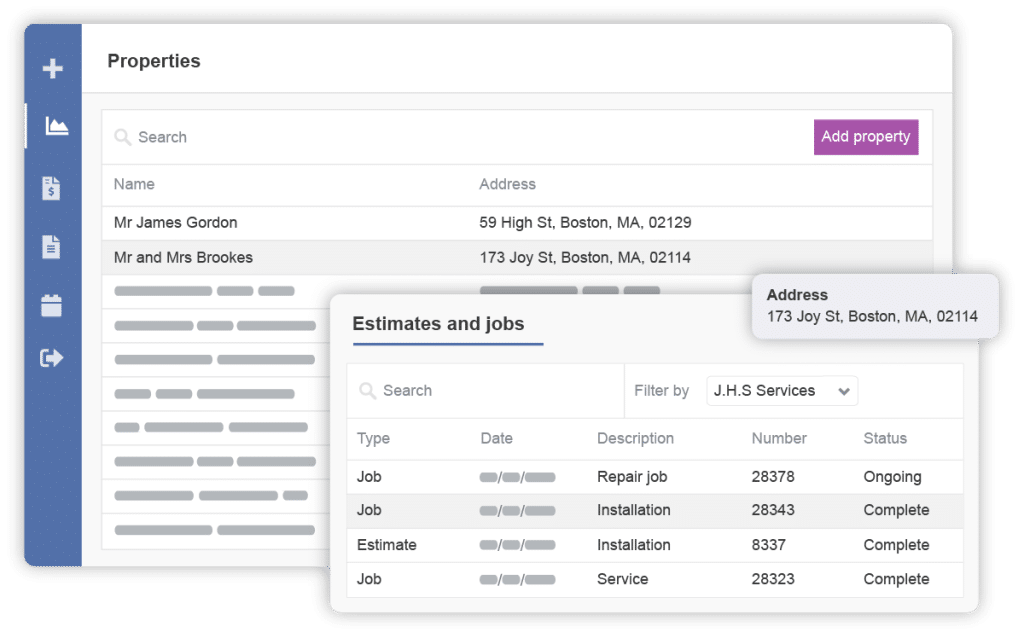Automated Appointment Reminder Ideas for the Trades
June 13, 2023 | Read: 11 minutes

For a trade business, a consistent flow of work is one of the most important aspects for finding success and increasing profitability.
Scheduling and managing work orders and appointments is no easy task, especially for a company that is focused on scaling its operations, making more money, and reducing costs…
But with the right technological system for automated appointment reminders – you can streamline client management and efficiently route field technicians for every job.
Keep reading to explore the benefits of automated appointment reminders and find new ideas to enhance your appointment reminder system and text!

What Are Automated Appointment Reminders?
Automated appointment reminders refer to the use of technology to send timely and personalized notifications to clients before their scheduled appointments.
These reminders can be in the form of text messages, emails, or even automated phone calls. They are designed to save resources and make sure individuals remember their upcoming appointments.
By leveraging automated appointment reminders, businesses in the trades industry can minimize no-shows, late cancellations, and the chances of miscommunication, allowing them to maximize their time and resources.
These reminders benefit maintenance providers and provide a convenient solution for customers who may have busy schedules or easily forget about their appointments.
Most of the time, they can be integrated into existing scheduling systems, making the implementation process accessible and smooth.
Benefits of Automated Appointment Reminders for Trade Companies
Improved Customer Communication and Satisfaction
Automated appointment reminders improve customer communication and satisfaction by providing timely and personalized notifications. By sending reminders through preferred channels such as SMS or email, trade companies can keep their customers informed about upcoming appointments or invoices, ensuring clarity and reducing the chances of misunderstandings.
Making things easier for your customers is always a good thing, especially when it comes to them leaving reviews and recommending you to friends. It’s paying attention to these small details that make a big difference.
Reduced No-Shows and Late Cancellations
No-shows and late cancellations can significantly impact trade companies, resulting in wasted time and lost revenue. However, automated appointment reminders help minimize these issues by serving as proactive reminders for customers. Nothing worse than having a tech drive to a job only to find that no one’s home because the customer thought they had an appointment next week. That’s wasted time, fuel, and, potentially, being able to attend a different job.
By sending reminders a day or two in advance, companies can significantly reduce the number of no-shows and late cancellations, allowing them to stick to their appointments calendars and allocate resources optimally.
Saved Time and Resources
Manual appointment reminders require considerable time and effort from administrative staff. It all sounds great in theory: send a confirmation email after they book, a reminder three days before, one the day before, and a final one on the morning of the appointment to let them know the tech is on their way. But if an actual person has to send these out manually, for each job, then you’ll have to send a lot of messages.
With automated systems in place, trade companies can simplify the reminder process, saving valuable time and assets. This automation lets employees focus on other essential tasks, increasing overall productivity and profitably.
Enhanced Operational Efficiency
The automated systems mentioned above will have to work in tandem with your customer relationship management (CRM) system in order to be able to access the customer information necessary.
This process allows for enhanced operational efficiency and organization. By integrating reminder systems with customer relationship management (CRM) software, trade companies can automate the entire process from booking appointments to sending reminders and follow-ups. The benefits of this automation are:
- Reduced likelihood of communication errors
- Reduced double bookings and other scheduling conflicts
- Reduced no-show appointments
- Increased first-time fix rates
Minimized Revenue Lost
Missed appointments directly impact a trade company’s revenue. However, automated appointment reminders help minimize revenue loss by significantly reducing the number of missed appointments. By reminding customers in advance, businesses can fill cancellations and reschedule appointments if necessary, ultimately maximizing revenue potential.
Upselling and Cross-Selling Opportunities
Automated appointment reminders can serve as an opportunity for field service companies to upsell or cross-sell their services. By including relevant offers, promotions, or suggestions in the reminder messages, companies can grab the customer’s attention and interest. This proactive approach can lead to additional sales or upgrades, increasing the average transaction value and overall profits.

Ways to Send Out Appointment Reminders
When it comes to managing work orders and keeping track of important jobs, sending out reminders is crucial. Reminders help ensure that both parties involved are well-prepared and don’t miss any scheduled engagements. With many different methods of communication, there are several effective ways to send out appointment reminders.
Try to keep in mind your customer base when deciding which one of these you want to use.
Elderly people might prefer actual letters in a mailbox, emails and text reminders will most likely satisfy everyone, while phone calls might not go down so well with Millennials (or at least 75% of them).
These are some popular communications methods:
SMS (Text Messages)
SMS (text messaging) has become one of the most widely used forms of service communication. It offers a quick and convenient way to send an appointment reminder text directly to clients’ mobile phones. With SMS appointment reminders, you can provide concise and necessary information, including the appointment time, the type of service, and any additional instructions. This method is particularly effective as people tend to have their phones with them at all times, making it highly likely that they will receive and read the reminders promptly.
Email remains a reliable and widely adopted method of communication, making it an excellent choice for automated appointment reminders. By sending them via email, you can provide more detailed information, attach relevant documents, or include links and photos. Email reminders are a great option for appointments that require more comprehensive instructions or pre-appointment preparations.
Automated Phone Calls
Automated phone calls offer an efficient way to deliver appointment reminders. With this method, a pre-recorded message is played on the recipient’s phone, providing them with the necessary details about their upcoming appointment. Automated phone calls are particularly useful when dealing with a large number of customers or when you need to reach individuals who may prefer a phone call.
Mobile Apps
In an increasingly mobile world, apps have gained significant popularity. Many organizations now offer a dedicated mobile app that lets users manage their appointments.
Appointment reminder apps provide a convenient platform to schedule, reschedule, and receive reminders all in one place.
Users can customize their notification settings, ensuring that they stay informed about upcoming appointments.

Online Customer Portals
For commercial businesses working with large clients, providing an online customer portal is one of the most efficient ways to communicate appointments.
Self-service technology allows individuals to log in to their accounts and access information related to their bookings. They can schedule, receive reminders, pay invoices, and even make changes to their accounts or upcoming jobs if necessary.
Making the customer feel in control with a self-service option isn’t something a lot of installation companies do, so it will definitely help you stand out from the competition!
Ideas for Automated Appointment Reminders
Automated appointment reminders can save time and streamline the communication process for trade businesses. By implementing automated systems, you can ensure that your customers get reminders without the need for your admin team to waste time on these small, repetitive tasks.
Here are some ideas for using automated appointment reminders effectively:
Pre-Appointment Automated Confirmation
Sending a pre-appointment confirmation reminder is a valuable way to ensure that your clients still want the slot for their scheduled appointments. This type of reminder can be sent 24-48 hours before the job and typically includes details such as the time, location, and an option to confirm or cancel the appointment. Automated pre-appointment confirmation reminders solidify the schedule in advance and allow you to make any necessary adjustments to not waste resources.
Day-of Reminders
A day-of reminder serves as a final prompt for individuals to remember their appointments. This type of reminder can be sent on the day of the appointment, ensuring that they are prepared to answer the door for your field technician. Day-of reminders can be concise and only need to include a message that lets them know the employees’ arrival time with an option to contact the company if needed.
Follow-Up Automated Appointment Reminders
Follow-up reminders are beneficial for appointments that require post-appointment actions or next steps. These reminders can be sent directly after the appointment to remind individuals of any tasks they need to complete or fill out a customer satisfaction survey. Follow-up reminders help keep your clients engaged and can be a great way to thank them for their business and keep the line of communication open.
Service Reminders
If your business offers recurring services, automated reminders can help your customers stay on top of their regular appointments. These reminders can be sent at predetermined intervals based on the frequency of the service. Service reminders can include options to reschedule a job along with any special promotions related to the work they had done in the past.
Rescheduling Options
Life can be unpredictable, and sometimes appointments need to be rescheduled. Including rescheduling options in your automated appointment reminders gives your customers the flexibility to make changes without any hassle or penalty. This can involve providing a link to a booking portal or contact information for rescheduling, allowing them to find available time slots that work for them.
Appointment Status Updates
In certain cases, it may be helpful to provide appointment status updates. For example, if there are delays or changes in the technicians’ schedule, sending a text or notification can help manage expectations and keep customers informed. On top of that, they create transparency and help maintain a positive customer experience.
Review Requests
After a successful appointment, consider including a review request in your follow-up. Many businesses struggle with gaining enough positive reviews and 92% of people report never buying/hiring without reading reviews.
Oftentimes, it’s only a matter of asking. This can be an opportunity for your customers to provide feedback and share their experiences. Including a link or instructions on how to leave a review can help you gather valuable testimonials and improve your services based on customer input.
Running Targeted Marketing Campaigns
If you have a group of clients set up on maintenance contracts or agreements, you can run a targeted marketing campaign for only those customers by using your automated appointment reminders.
This can help you organize your schedule far in advance! By making clients book their subscription services during your traditionally slow periods, you can maximize the productivity of your technicians.
Two Related Trends in Field Service Technology
1. Smart Technologies and IoT Devices
If you aren’t familiar with IoT devices – check out our article that discusses them a bit more in-depth.
Smart devices (such as watches or home assistants) can serve as additional channels for reminders, providing convenient and timely notifications to customers wherever they are.
Integrating IoT data with appointment scheduling systems creates real-time updates and personalized reminders tailored to each customer’s needs and location.
2. Artificial Intelligence (AI) or Machine Learning
With all of the buzz surrounding Artificial Intelligence (AI) and machine learning, you’ve probably considered finding a way to utilize it for your business.
AI-powered algorithms have the potential to look through your historical appointment data and analyze it for the best times and channels for reminders.
It can also be used to personalize messages based on individual preferences and anticipate scheduling conflicts before they occur.
These technologies are still in the early stages, but field service organizations can use them to help optimize their reminder strategies for maximum impact.
Leveraging Automated Appointment Reminder Templates
Automated appointment reminder templates can be a game-changer for businesses and organizations looking to upgrade their communication processes.
By leveraging pre-designed templates, you can save time and effort while ensuring consistent and professional reminders are sent to everyone who interacts with your business.
Start Sending Reminders Today with Appointment Reminder Software
If your field technicians and administrative team aren’t on the same page, it can waste valuable resources and damage your brand or reputation.
Automated reminder software can revolutionize the way you handle your appointment management and communication processes.
Get ahead of the game and download our free service reminder templates below!

Cristina Maria
I'm here to bring you next-level strategies to the field service industry. When I'm not working on the best tips to grow your business, I'm on the lookout for sci-fi novels and cookie recipes.








